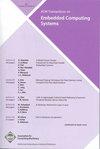融合激光雷达和惯性传感器的鲁棒嵌入式自动驾驶定位系统
IF 2.6
3区 计算机科学
Q2 COMPUTER SCIENCE, HARDWARE & ARCHITECTURE
引用次数: 0
摘要
自动驾驶强调在有限资源的嵌入式系统上进行精确的多传感器融合定位。以激光雷达为中心的传感器融合系统对光照和视点变化不敏感,成为主流导航系统。然而,这些类型的系统在使用有限的机载资源处理大规模顺序LiDAR数据时受到影响,导致LiDAR集中式传感器融合不切实际。因此,在大多数主流定位方法中,利用平面和边缘等手工制作的特征来缓解这种不满意,从而引发LiDAR惯性传感器融合的新基石。然而,这种超轻量的特征提取虽然在以lidar为中心的传感器融合中实现了实时约束,但在高速旋转或平移扰动下存在严重的脆弱性。本文提出了一种基于稀疏张量的激光雷达惯性融合方法,用于自动驾驶嵌入式系统。利用稀疏张量的力量提取全局几何特征,减轻了点云稀疏性的缺陷。采用惯性传感器克服了粗阶逐点内线匹配费时的问题。我们在代表性的数据集基准和现实场景上构建我们的实验。评价结果表明,与经典方法相比,该方法具有较好的鲁棒性和准确性。本文章由计算机程序翻译,如有差异,请以英文原文为准。
Robust Embedded Autonomous Driving Positioning System Fusing LiDAR and Inertial Sensors
Autonomous driving emphasizes precise multi-sensor fusion positioning on limit resource embedded system. LiDAR-centered sensor fusion system serves as mainstream navigation system due to its insensitivity to illumination and viewpoint change. However, these types of system suffer from handling large-scale sequential LiDAR data using limit resouce on board, leading LiDAR-centralized sensor fusion unpractical. As a result, hand-crafted feature such as plane and edge are leveraged in majority mainstream positioning methods to alleviate this unsatisfaction, triggering a new cornerstone in LiDAR Inertial sensor fusion. However, such super light weight feature extraction, although achieves real-time constraint in LiDAR-centered sensor fusion, encounters severe vulnerability under high speed rotational or translational perturbation. In this paper, we propose a sparse tensor based LiDAR Inertial fusion method for autonomous driving embedded system. Leveraging the power of sparse tensor, the global geometrical feature is fetched so that the point cloud sparsity defect is alleviated. Inertial sensor is deployed to conquer the time-consuming step caused by the coarse level point-wise inlier matching. We construct our experiments on both representative dataset benchmarks and realistic scenes. The evaluation results show the robustness and accuracy of our proposed solution comparing to classical methods.
求助全文
通过发布文献求助,成功后即可免费获取论文全文。
去求助
来源期刊

ACM Transactions on Embedded Computing Systems
工程技术-计算机:软件工程
CiteScore
3.70
自引率
0.00%
发文量
138
审稿时长
6 months
期刊介绍:
The design of embedded computing systems, both the software and hardware, increasingly relies on sophisticated algorithms, analytical models, and methodologies. ACM Transactions on Embedded Computing Systems (TECS) aims to present the leading work relating to the analysis, design, behavior, and experience with embedded computing systems.
 求助内容:
求助内容: 应助结果提醒方式:
应助结果提醒方式:


